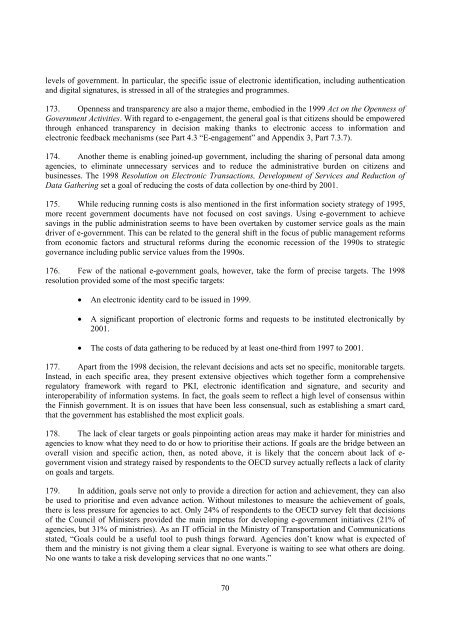e-GOVERNMENT IN FINLAND - ePractice.eu
e-GOVERNMENT IN FINLAND - ePractice.eu
e-GOVERNMENT IN FINLAND - ePractice.eu
Create successful ePaper yourself
Turn your PDF publications into a flip-book with our unique Google optimized e-Paper software.
levels of government. In particular, the specific issue of electronic identification, including authentication<br />
and digital signatures, is stressed in all of the strategies and programmes.<br />
173. Openness and transparency are also a major theme, embodied in the 1999 Act on the Openness of<br />
Government Activities. With regard to e-engagement, the general goal is that citizens should be empowered<br />
through enhanced transparency in decision making thanks to electronic access to information and<br />
electronic feedback mechanisms (see Part 4.3 “E-engagement” and Appendix 3, Part 7.3.7).<br />
174. Another theme is enabling joined-up government, including the sharing of personal data among<br />
agencies, to eliminate unnecessary services and to reduce the administrative burden on citizens and<br />
businesses. The 1998 Resolution on Electronic Transactions, Development of Services and Reduction of<br />
Data Gathering set a goal of reducing the costs of data collection by one-third by 2001.<br />
175. While reducing running costs is also mentioned in the first information society strategy of 1995,<br />
more recent government documents have not focused on cost savings. Using e-government to achieve<br />
savings in the public administration seems to have been overtaken by customer service goals as the main<br />
driver of e-government. This can be related to the general shift in the focus of public management reforms<br />
from economic factors and structural reforms during the economic recession of the 1990s to strategic<br />
governance including public service values from the 1990s.<br />
176. Few of the national e-government goals, however, take the form of precise targets. The 1998<br />
resolution provided some of the most specific targets:<br />
x An electronic identity card to be issued in 1999.<br />
x A significant proportion of electronic forms and requests to be instituted electronically by<br />
2001.<br />
x The costs of data gathering to be reduced by at least one-third from 1997 to 2001.<br />
177. Apart from the 1998 decision, the relevant decisions and acts set no specific, monitorable targets.<br />
Instead, in each specific area, they present extensive objectives which together form a comprehensive<br />
regulatory framework with regard to PKI, electronic identification and signature, and security and<br />
interoperability of information systems. In fact, the goals seem to reflect a high level of consensus within<br />
the Finnish government. It is on issues that have been less consensual, such as establishing a smart card,<br />
that the government has established the most explicit goals.<br />
178. The lack of clear targets or goals pinpointing action areas may make it harder for ministries and<br />
agencies to know what they need to do or how to prioritise their actions. If goals are the bridge between an<br />
overall vision and specific action, then, as noted above, it is likely that the concern about lack of egovernment<br />
vision and strategy raised by respondents to the OECD survey actually reflects a lack of clarity<br />
on goals and targets.<br />
179. In addition, goals serve not only to provide a direction for action and achievement, they can also<br />
be used to prioritise and even advance action. Without milestones to measure the achievement of goals,<br />
there is less pressure for agencies to act. Only 24% of respondents to the OECD survey felt that decisions<br />
of the Council of Ministers provided the main impetus for developing e-government initiatives (21% of<br />
agencies, but 31% of ministries). As an IT official in the Ministry of Transportation and Communications<br />
stated, “Goals could be a useful tool to push things forward. Agencies don’t know what is expected of<br />
them and the ministry is not giving them a clear signal. Everyone is waiting to see what others are doing.<br />
No one wants to take a risk developing services that no one wants.”<br />
70
















